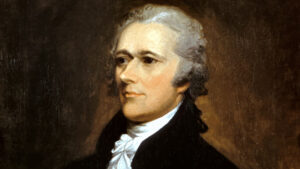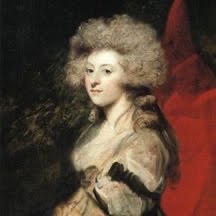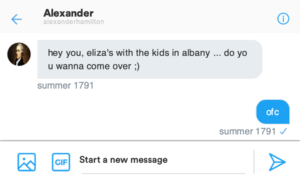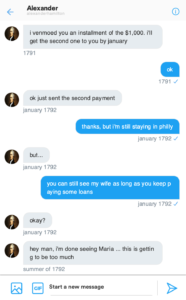Ah so … you want to know more about the *scandy* affair between Hamilton and Maria. Well you, my friend, are in the right place.
A little background info before we get started.
This is Alexander Hamilton (a star in the fan-favorite: HAMILTON the Musical):

Hamilton was the first secretary of the United States Treasury (kind of a big deal) and built the foundations of the national banking system. Unfortunately, he died in a duel against Aaron Burr (long story short, there was just a lot of beef).
and this is Maria Reynolds:

She claimed to have an abusive husband, James Reynolds, who left her and her young daughter to run off with another cutie.
Maria went to Hamilton’s family home in Philly in the summer of 1791 to ask him for some money to get to her friends in New York. Hamilton, being the gentleman he is, brought a 30-note bill to Maria’s house. The young lady brought him upstairs and that’s when things got a little steamy.
Maria and Hamilton began a *sexual* relationship and would meet up at Hamilton’s home.

Meanwhile, his loyal wife, Eliza, was in Albany with their children visiting her father.

James Reynolds found out about the affair and confronted Hamilton.
@jamesreynolds: a little birdie told me a very important person is sneaking around with my wife… @alexanderhamilton
@alexanderhamilton: what do you want @jamesreynolds
@jamesreynolds: $1,000 should suffice @alexanderhamilton
@alexanderhamilton: word.

Alexander called it quits on his affair with Maria in the summer of 1792.
Later on, James Reynolds and his associate, Jacob Clingman, were arrested and imprisoned for involvement in a scheme to defraud the government by posing as executors of deceased Revolutionary War veterans to get money.
Talk about risky business.
Clingman went to his former employer, Frederick Muhlenberg, while out on bail and and claimed Reynolds was involved in illegal stuff with Hamilton.
Muhlenberg and colleagues James Monroe and Abraham Venable visited James Reynolds in jail and Maria Reynolds at home. After hearing their stories, they confronted Hamilton in person. He showed them his exchanges with Maria.
@frederickmuhlenberg: @alexanderhamilton exposed.
@jamesmonroe: hey @thomasjefferson i’ve got some of Hamilton’s letters for you
Sneaky John Beckley, the clerk for the House of Representatives, kept a copy of Alexander’s documents.
The Reynolds’ split (Aaron Burr was Maria’s attorney) and Maria married Clingman – remember him? none other than James’ associate – the same day her divorce was official.
In the fall of 1796, Hamilton came for Jefferson’s rumored relationship with his slave Sally Hemmings.
@alexanderhamilton: heard things are getting spicy with Sally @thomasjefferson
Journalist James Callendar, let’s say not the biggest fan of Hamilton, called him out on his own scandalous history.
@callendarnotcalendar: okay @alexanderhamilton but didn’t you use federal funds to handle your personal business … mhm … that’s what i thought
@alexanderhamilton: did @jamesmonroe give you that info??
@callendarnotcalendar: i don’t snitch
@elizahamilton: i don’t usually get involved in this kind of stuff but are you serious @jamesmonroe? these are our personal issues. stay out of it.
@jamesmonroe: wow wow wow i don’t know how the letters resurfaced
@elizahamilton: i will never forgive you.
However, although Hamilton blamed Monroe, it was most likely John Buckley who gave Callendar access to the documents after the Federalists fired him as the House clerk.
In 1797, Hamilton published the Reynolds Pamphlet that shared the details of his affair with Maria Reynolds and the blackmail payments he made out to James Reynolds, ruining any chances he had of becoming president.

@elizahamilton: i’m so embarrassed
In the 1700s, most content was physically published – like Alexander Hamilton’s Reynolds Pamphlet. It would be interesting to see, though, how this document would have been received by the public had it been published online/on Twitter. Would they annotate it? Troll it? Would Hamilton block people? With Twitter, private matters, especially for public figures, are publicized. In Bonnie Stewart’s article “In Public: The Shifting Consequences of Twitter Scholarship.” she states that “networks’ capacity to turn into full-scale publics at any moment has become increasingly visible. Where academic Twitter once seemed quietly parochial and collegial almost to the point of excess, it is now thrust into the messy, contested business of being truly open to the public”. If Hamilton had remained silent on Twitter, he would have faced consequences, and if he had posted his letter, he would face consequences of public scholarship, the public’s online reactions (anonymous or not) through retweeting, public bashing/humiliation, or “cancellation”. With his situation, a scandal like this, he would have definitely had a hard time in the realm of Twitter scholarship.
Pruitt, Sarah. The Scandal That Ruined Alexander Hamilton’s Chances of Becoming President. 20 Apr. 2018, www.history.com/news/alexander-hamilton-maria-reynolds-pamphlet-affair.
Stewart, Bonnie. “In Public: The Shifting Consequences of Twitter Scholarship.” Hybrid Pedagogy, Apr. 2015, https://hybridpedagogy.org/in-public-the-shifting-consequences-of-twitter-scholarship/.
